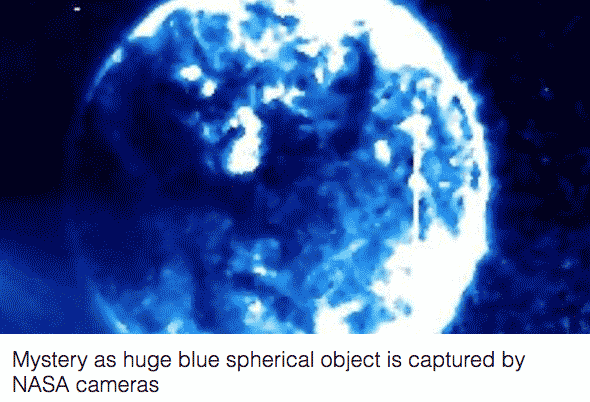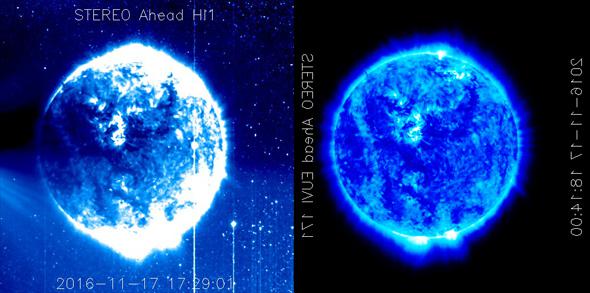For reasons that elude me now, I decided to check on Facebook on Sunday night before going to bed. On the right sidebar, I noticed that it said that “NASA” was trending. That surprised me; had I missed some important event or amazing new Hubble image being released?
I clicked on the link, saw the news item, and let out a long sigh. This is what I saw:

Yup. Another “Space telescope takes a picture we don’t understand and therefore it must be a UFO/Nibiru/NASA coverup/End times/cats-and-dogs-living together situation.” In this case it’s a huge blue globe appearing “in front of the Sun.” Except, of course, it’s nothing of the sort.
Pardon my snark, but this ain’t my first rodeo here. I’ve had to debunk stuff exactly like this dozens of times, and it’s almost always the same story.
On the Facebook trends page there were links to a few articles, the first being to that epitome of accuracy, the U.K. tabloid Daily Mail (for context, I heard the Mail got a science story right once, but I’ve never been able to verify that). The article quotes people making a lot of breathless claims, like the Sun “reacted” to the sphere, or that it might be a “rouge [sic] planet.” A photo caption claims it’s a huge blue sphere and it’s “mystifying scientists.”
Sure. Except no.
I’ll explain in a sec, but first things first: How did this all start? Apparently, a woman named Pamela Johnson posted about this on Facebook, which got the ball rolling. It’s an image from NASA’s STEREO A spacecraft, one of a pair of probes orbiting the Sun. They were launched in opposite directions, designed to take images of the Sun from different angles, and provide a more global view of our tempestuous star. STEREO B has been having some issues lately due to hardware problems, but STEREO A is still ticking along, on the other side of the Sun from the Earth.

NASA / STEREO
The image is weird, certainly. Johnson makes some, um, unorthodox claims about it involving New Age things that I won’t delve into.
Being more of a sciencey persuasion, I looked at the image carefully to try to figure out what I was seeing. I went to the STEREO image search page and found images from that date. Quite a few show the anomaly, while others don’t. At the top of this article is a cleaner shot of one of the images, taken on Thursday at 17:29 UTC.
The two bright spots with vertical lines going through them I recognized as planets right away; planets are bright and overload the detectors a bit, bleeding light into neighboring pixels (this is called blooming and happens all the time in digital detectors, including spacecraft that observe the Sun; UFO hunters and Planet X conspiracy theorists tend to go bananas over such things). Incidentally, the planet to the lower right is Venus, and the one closer to center is … Earth! Because STEREO is on the other side of the Sun, the Earth is in its field of view. So that’s us! Cool.
As for the giant blue ball, that’s no mystery: It’s the Sun. I mean, clearly that’s what it is. The real question is why it appears to be superposed on the image of the planets.
Briefly, the image comes from an instrument on STEREO called the Sun Earth Connection Coronal and Heliospheric Investigation, or SECCHI. This has several detectors on it, including the Heliospheric Imager, or HI, which is a visible-light camera designed to look at the Sun’s corona, its faint atmosphere that streams into space. [Update: To be clear, it doesn’t point directly at the Sun, but instead off to the side to better see the corona.] The image showing the two planets is from HI.
But the image of the Sun is definitely not in visible light. I knew right away it was either in ultraviolet or X-ray; the Sun writhes and fumes under its intense magnetic fields, and that’s best seen at those higher energy forms of light.
So why is there a visible light image combined with a UV one? Instead of supposing there are higher dimensional beings warning us about the oncoming Trump presidency, I did something truly silly: I contacted some scientists involved with STEREO who might know the actual answer. Karen Fox, Joe Gurman, and Alex Young at NASA’s Goddard Space Flight Center quickly got back to me. The answer is pretty simple, and makes perfect sense: Sometimes, the image processor onboard STEREO gets overloaded, and becomes “confused.” When that happens, the images get corrupted, and sometimes two images from two different cameras get combined.
That’s precisely what happened here. The HI image was combined with one from the Extreme Ultraviolet (aha!) Imager, producing the bizarre image seen. EUVI takes images at various wavelengths of UV light (think of them as different colors), and this one is from a 17.1 nanometer image, which is where highly energized iron atoms emit. These trace the Sun’s activity well, and that’s why the image shows so many interesting features. The bright spot is where magnetic activity is especially intense, most likely due to a sunspot.
I found an EUVI image from around the same time as the weird one. The features were very similar. I rotated and flipped it to match the HI image (different cameras have different orientations and readout directions); here they are side by side.

NASA/STEREO
Voilà.
Not-so-incidentally, each wavelength seen by EUVI is displayed using a different color to help distinguish them. They aren’t true colors—our eyes can’t see in the ultraviolet—but done as a way to easily identify each wavelength and keep them straight. The EUVI 17.1 nm images are colored blue. So it’s not a “huge blue sphere.” It’s a huge ultraviolet one that’s been colored blue.
AKA the Sun.
So there you have it. No conspiracy, no higher power. Just a glitchy computer.
Of course, another way to think about it is this: It’s a glitchy computer in a space probe launched in 2006 on a huge rocket that took it around the Earth’s orbit to the other side where it uses a complex and sophisticated suite of powerful scientific instruments to track our Sun in wavelengths invisible to the human eye so that we can better understand what it’s like to live in the outer atmosphere of one of the Universe’s most mighty denizens: a full-blown star.
Reality is WAY cooler than nonsense.
